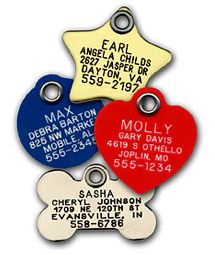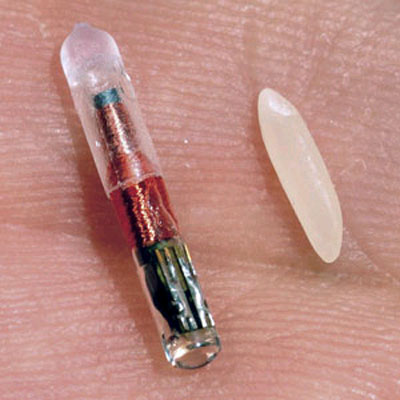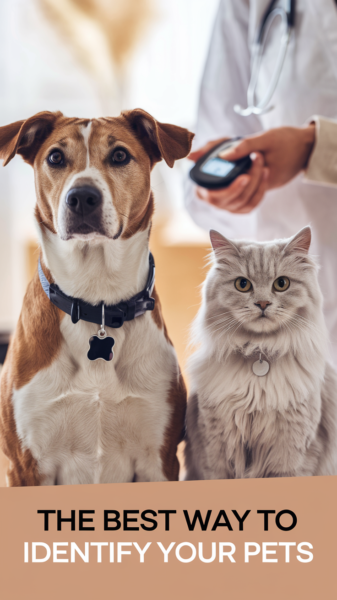Making Sure Others Can Identify Your Pet Can Save Its Life
Every year, millions of cats and dogs are euthanized at shelters across the United States. The vast majority of these have been picked up as strays and have no identification. Sadly, one in three family pets will get lost during its lifetime, and without identification, around 90 percent will not return home. Many of those euthanized are beloved family members that just couldn’t be found by their owners. That’s why it is so important for you to know how to identify your pet.
Pets become “strays” for lots of reasons. Dogs dig out of their yard or jump the fence. Cats and dogs slip out of doors accidentally left open. They may escape from the car during travel. They may simply slip out of their collars during a walk and run off. Many pets get lost on the 4th of July when they become frightened by fireworks.
Responsible pet owners want to be proactive about protecting their four-legged family members. What can you do to identify your pet to make sure your cat or dog doesn’t add to the statistics in local shelters?
Identification Tags
Identification tags can be the best and quickest way for your pet to find its way home. Your pet should wear its collar at all times, not just when walking outdoors or traveling. All too often, pets slip out without their collars because owners think they don’t need them in the house.
home. Your pet should wear its collar at all times, not just when walking outdoors or traveling. All too often, pets slip out without their collars because owners think they don’t need them in the house.
Cat’s should wear a collar with identification too! They need a special breakaway collar made for cats, but it is still the best way to get them returned when they become lost.
What to Put (and not Put) on Your Pet’s ID Tag
As a first level of defense, your pet’s ID tag could mean a quick return home. Be sure your pet ID tag has all the essential information. Your pet’s name IS NOT one of those essential items! Putting your pets name on its tag can even be unsafe – it can make it easier for someone to steal it. Here’s the information you should put on your pet’s tag.
- Your phone number is the most important thing on your pet’s tag.
- Your name is the second most important so that a caller can be sure they have the right person.
- Your city and state will let whoever finds your pet know just how far the animal has traveled and how much additional help it may or may not need beyond simply taking it in and calling the owner.
- If your pet requires any special medical attention, it’s extremely important to include it on his ID tag. Some pet owners even include the phrase “Needs Medication” or “Special Medical Needs” on their pet’s tags regardless of whether the animal actually has a health issue or not.
Microchipping to Identify Your Pet
The problem with ID tags is that collars break, they are easily removed by thieves, and owners don’t put them on in the house.
Microchipping can help in these situations. A microchip is about the size of a grain of rice and is injected just under the skin. The device carries a number, and this number is plugged into a database that includes the name and contact information of a pet’s owner. AVID and HomeAgain are the largest sellers of the microchips. It is critical that you keep your information up-to-date in the database.
Your Pet Still Needs a Collar!
But don’t think that because your pet is microchipped it doesn’t need a collar. As effective as these chips are, they are not fool proof and are actually only effective if the pet is taken to a vet or facility that can read the chip to get the information off of it. More and more shelters are able to read the chips but if your pet is found by someone who doesn’t turn it into the shelter, they don’t have the ability to read the chip and may not even know it is there.
Common microchip brands and how to contact them:
| Manufacturer | Telephone Number | Website |
| 24 PetWatch | 1-866-597-2424 | www.24petwatch.com |
| AKC | 1-800-252-7894 | www.akccar.com |
| AVID | 1-800-336-2843 | www.avidid.com |
| Banfield | 1-877-567-8738 | www.banfield.net |
| HomeAgain | 1-888-466-3242 | www.homeagain.com |
| Bayer ResQ | 1-877-738-5465 | www.petlink.pet |
Do It Yourself Microchips
Did you know you can buy microchips, readers and smart ID tags on Amazon?
Microchips for pets purchased on Amazon are often unregistered at the time of purchase. To register the microchip, you’ll typically follow these steps:
1. Locate the Microchip Information
- The microchip packaging or included paperwork will usually have the microchip’s unique identification number (a series of numbers and/or letters).
- It may also provide information about the microchip brand or manufacturer.
2. Visit the Manufacturer’s Website
- Identify the microchip’s manufacturer (e.g., HomeAgain, AKC Reunite, Avid).
- Go to the manufacturer’s official website or the registry associated with the microchip.
3. Register the Microchip
- Create an account on the registry’s website if you don’t already have one.
- Enter the microchip number and provide the required details, which typically include:
- Your contact information (name, phone number, address, email).
- Pet’s details (name, species, breed, color, age, etc.).
- Some registries may charge a one-time or annual fee for registration or additional services like updates and alerts.
4. Consider Universal Registration
- Register the microchip with a universal database like PetLink or Found Animals Registry, even if the microchip is already registered with the manufacturer. This adds an extra layer of security in case the original registry isn’t checked.
5. Test the Microchip
- Once registered, have a vet or shelter scan the microchip to confirm that it works and the details are correctly linked to your pet.
6. Keep Details Updated
- Always update the registry if your contact information changes to ensure you can be reached if your pet is lost.
Additional Tips:
- If you can’t determine the manufacturer, use an online database like the AAHA Universal Pet Microchip Lookup Tool to identify which registry corresponds to the microchip number.
- Some microchips on Amazon might include a code for free or discounted registration, so check the packaging carefully.
Conclusion
Ensuring your pet has both an ID tag and a registered microchip is one of the most responsible steps you can take as a pet owner. While ID tags provide an immediate way for someone to contact you, microchips serve as a reliable backup in case the tag is lost. Together, they significantly increase the chances of a happy reunion if your pet ever goes missing.
Don’t wait until it’s too late—double-check that your pet’s ID tag information is up-to-date and that their microchip is registered with your current contact details. Take this simple step today to ensure your furry friend stays safe and connected to you no matter what.
Have you updated your pet’s ID and microchip recently? Let us know in the comments!




























Pingback: Sick Kittens Nursed back to Health for MeoowzResQ - Savvy Pet Care